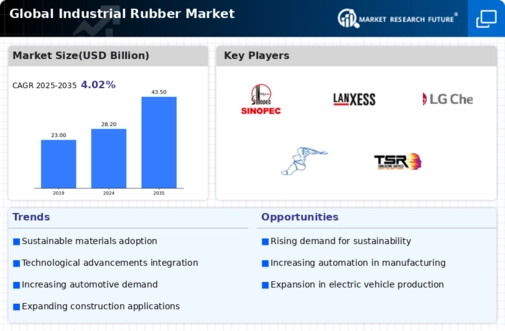Market Share
Industrial Rubber Market Share Analysis
In the fiercely competitive landscape of the Industrial Rubber market, market share positioning strategies are crucial for companies aiming to establish a strong presence, differentiate themselves, and capture a significant portion of the market. Industrial rubber, a versatile material used in various applications such as automotive, construction, manufacturing, and aerospace, presents companies with opportunities to leverage strategic approaches to gain a competitive edge.
One of the primary strategies employed by companies in the Industrial Rubber market is product differentiation. By offering innovative rubber formulations, compounds, and products with unique features, functionalities, and performance characteristics, companies can set themselves apart from competitors and appeal to the specific needs of customers in different industries. For example, companies may develop rubber compounds with enhanced durability, heat resistance, chemical resistance, or low-temperature flexibility to meet the demanding requirements of automotive components, industrial machinery, or specialized applications. The factors involved in the rise of the global Industrial Rubber Market are increased usage, supply, and demand of rubber in industries such as electronics, electrical, automotive, industrial manufacturing, building, construction, and others.
Additionally, strategic partnerships and collaborations are essential for companies to expand their market share and reach new customer segments in the Industrial Rubber market. By forming alliances with raw material suppliers, distributors, manufacturers, or industry associations, companies can leverage complementary strengths, resources, and expertise to enhance their market presence and penetration. Collaborating with automotive manufacturers to supply rubber components, partnering with construction companies for infrastructure projects, or working with research institutions to develop innovative rubber technologies can help companies strengthen their market position and gain access to new opportunities.
Furthermore, geographic expansion is a key strategy for companies looking to increase their market share and presence in different regions and countries. By targeting emerging markets with high growth potential, companies can capitalize on increasing demand for Industrial Rubber products driven by economic development, urbanization, and infrastructure investment. Establishing local production facilities, distribution networks, and sales channels allows companies to better serve regional markets, adapt to local preferences and regulations, and respond quickly to customer needs and market trends.
Investment in research and development (R&D) is essential for companies to maintain their competitive advantage and market share positioning in the Industrial Rubber market. By investing in R&D initiatives focused on material science, process optimization, and product innovation, companies can develop cutting-edge rubber formulations, manufacturing technologies, and application solutions that meet the evolving needs of customers and industries. Developing eco-friendly rubber compounds, recyclable materials, or specialized rubber products for niche applications can help companies differentiate themselves and capture market share in competitive market segments.
Moreover, marketing and branding strategies are crucial for companies to effectively communicate their value proposition, strengthen brand awareness, and influence customer perceptions in the Industrial Rubber market. By implementing targeted marketing campaigns, advertising strategies, and promotional activities, companies can educate customers about the benefits and applications of their rubber products, showcase their expertise and capabilities, and build trust and loyalty with customers. Participating in industry events, trade shows, and exhibitions also provides companies with opportunities to showcase their products, network with key stakeholders, and stay updated on market trends and competitors' activities.
Furthermore, pricing strategies play a significant role in market share positioning, as companies seek to balance profitability with competitiveness in the Industrial Rubber market. By adopting flexible pricing strategies based on factors such as production costs, market demand, competitor pricing, and customer value perception, companies can optimize their pricing decisions to maximize market share and profitability. Offering competitive pricing packages, volume discounts, and value-added services can help companies attract new customers, retain existing ones, and gain market share in highly competitive market segments.









Leave a Comment